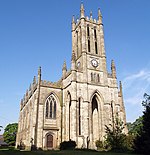Bury Hebrew Congregation
Bury, Greater ManchesterOrthodox synagogues in EnglandReligion in Greater ManchesterSynagogues in Manchester
Bury Hebrew Congregation, also known as Bet Knesset Sha'ar HahShamayim (Gate of Heaven Synagogue) is an Orthodox synagogue, serving the Jewish community in the Sunnybank, Unsworth and Hollins area of North Manchester.
Excerpt from the Wikipedia article Bury Hebrew Congregation (License: CC BY-SA 3.0, Authors).Bury Hebrew Congregation
Sunny Bank Road,
Geographical coordinates (GPS) Address Nearby Places Show on map
Geographical coordinates (GPS)
| Latitude | Longitude |
|---|---|
| N 53.562883 ° | E -2.290864 ° |
Address
Bury Hebrew Congregation
Sunny Bank Road
BL9 8HE , Blackford Bridge
England, United Kingdom
Open on Google Maps








